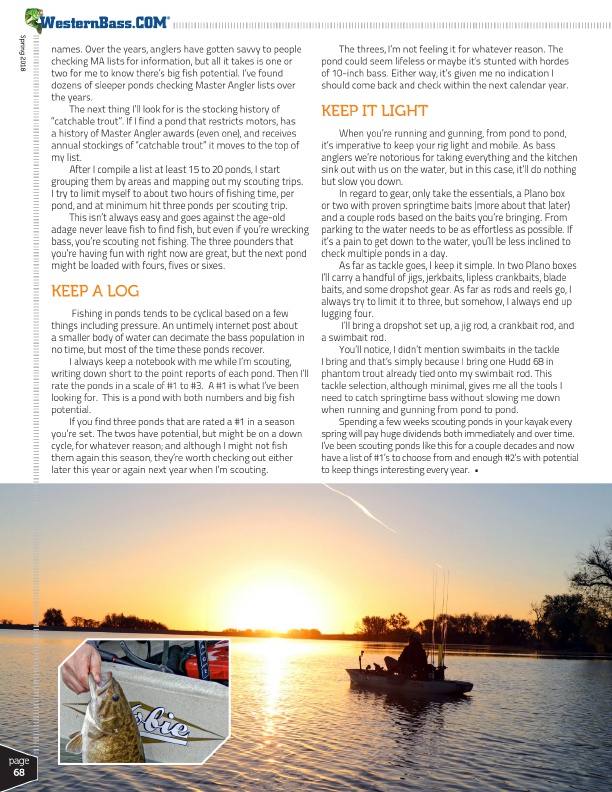
Spring 2018
®
names. Over the years, anglers have gotten savvy to people checking MA lists for information, but all it takes is one or two for me to know there’s big fish potential. I’ve found dozens of sleeper ponds checking Master Angler lists over the years.
The next thing I’ll look for is the stocking history of “catchable trout”. If I find a pond that restricts motors, has a history of Master Angler awards (even one), and receives annual stockings of “catchable trout” it moves to the top of my list.
After I compile a list at least 15 to 20 ponds, I start grouping them by areas and mapping out my scouting trips. I try to limit myself to about two hours of fishing time, per pond, and at minimum hit three ponds per scouting trip.
This isn’t always easy and goes against the age-old adage never leave fish to find fish, but even if you’re wrecking bass, you’re scouting not fishing. The three pounders that you’re having fun with right now are great, but the next pond might be loaded with fours, fives or sixes.
KEEP A LOG
Fishing in ponds tends to be cyclical based on a few things including pressure. An untimely internet post about a smaller body of water can decimate the bass population in no time, but most of the time these ponds recover.
I always keep a notebook with me while I’m scouting, writing down short to the point reports of each pond. Then I’ll rate the ponds in a scale of #1 to #3. A #1 is what I’ve been looking for. This is a pond with both numbers and big fish potential.
If you find three ponds that are rated a #1 in a season you’re set. The twos have potential, but might be on a down cycle, for whatever reason; and although I might not fish them again this season, they’re worth checking out either later this year or again next year when I’m scouting.
The threes, I’m not feeling it for whatever reason. The pond could seem lifeless or maybe it’s stunted with hordes of 10-inch bass. Either way, it’s given me no indication I should come back and check within the next calendar year.
KEEP IT LIGHT
When you’re running and gunning, from pond to pond, it’s imperative to keep your rig light and mobile. As bass anglers we’re notorious for taking everything and the kitchen sink out with us on the water, but in this case, it’ll do nothing but slow you down.
In regard to gear, only take the essentials, a Plano box or two with proven springtime baits (more about that later) and a couple rods based on the baits you’re bringing. From parking to the water needs to be as effortless as possible. If it’s a pain to get down to the water, you’ll be less inclined to check multiple ponds in a day.
As far as tackle goes, I keep it simple. In two Plano boxes I’ll carry a handful of jigs, jerkbaits, lipless crankbaits, blade baits, and some dropshot gear. As far as rods and reels go, I always try to limit it to three, but somehow, I always end up lugging four.
I’ll bring a dropshot set up, a jig rod, a crankbait rod, and a swimbait rod.
You’ll notice, I didn’t mention swimbaits in the tackle I bring and that’s simply because I bring one Hudd 68 in phantom trout already tied onto my swimbait rod. This tackle selection, although minimal, gives me all the tools I need to catch springtime bass without slowing me down when running and gunning from pond to pond.
Spending a few weeks scouting ponds in your kayak every spring will pay huge dividends both immediately and over time. I’ve been scouting ponds like this for a couple decades and now have a list of #1’s to choose from and enough #2’s with potential to keep things interesting every year. •
page 68